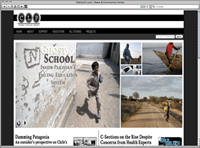During their travels they produced stories for a number of small independent media outlets, earning themselves enough credentials to get a grant from their local NPR affiliate to produce a series chronicling life on Washington’s Duwamish River.
The Duwamish story won a regional Edward R. Murrow Award, and in 2008 the team convinced the Pulitzer Center to fund a trip to East Africa to report on water scarcity issues. Their stories on the subject were picked up across a wide array of media outlets.
By this point, what became known as Common Language Project was well on its way to being an established reporting team as well as a web publication. According to Partnow, CLP’s executive director, the team has always been trying to find the balance between existing as CLPmag.org–a publication in its own right–and existing as a sort of international/ multimedia newswire. It wasn’t until recently, she says, that they’ve fully embraced the idea of existing as both.
CLP started as a nonprofit by filing under the umbrella of the Urbana-Champaign Independent Media Center in 2005, then filed for its own nonprofit status in December 2006 (the three CLP members had returned from that first reporting trip in September of that year).
Where other, more traditional global reporting sites have popped up in the wake of mass layoffs, CLP is focused on creating a specific brand for their reportage. “As far as the journalism that we do, two goals are to cover underreported stories and to experiment with different forms,” says Partnow. “When everyone is looking at a region from a macro point of view, we wonder ‘what does everyday life look like?'”
It’s a common theme in all of their coverage. In 2009, when Pakistan garnered global headlines because of its significance to the west’s war on terror, the team travelled there on a Pulitzer Center Grant and focused its coverage not on Islamic militancy and government instability, but on education: specifically, the problem of the country’s “ghost schools,” some 30,000 non-functioning or empty schools that exist on paper only to pad education stats. Their coverage of the issue typified another tenant of the CLP ethos: multimedia. The team produced photo, audio, and text coverage from their trip. Their reporting from Pakistan also appeared widely in other publications, including public radio, the Seattle Times, and GlobalPost.
Common Language Project operates as a 501(c)3 nonprofit and receives funding from a variety of sources, including grants from the Pulitizer Center on Crisis Reporting, the Foundation for Global Community, and hundreds of individual donors. In 2009, the project was “adopted” by the University of Washington’s communications department after a chance meeting with Hanson Hosein, director of the masters of communication in digital media program, at a CLP fundraiser. It’s a partnership that Partnow sees as beneficial to both entities. While the University houses and provides operational funding for the CLP, the CLP team runs media workshops, teaches classes, and works on media literacy outreach in local Seattle high schools.
The structure of the CLP brings to mind that of a collective. It’s a group of like-minded people: journalists who operate together with a shared focus on international reporting, experimentation with form, and a dedication to the human element in every issue. The group’s reporting on a former Marine’s return to Iraq as a civilian included the work of a comic book artist, whose illustrations from the trip will ultimately be published as a book.
As for the future, Partnow anticipates growth, within reasonable means. “I don’t know that CLP is ever going to have as big of an audience as the legacy media outlets, but we definitely see it growing,” she says. For now, they will continue to serve up their unique brand of straight-from-the-notebook human stories. “It’s sort of a sweet spot for us, behind-the-scenes,” says Partnow. “We like to peel back a few layers and tell the human stories.”
 SEATTLE, WASHINGTON —In 2005, three friends on their way to becoming freshly anointed college grads had an idea. They were budding journalists with global ambitions who didn’t want to sit on their hands while foreign coverage in American newspapers continued to fade. The three, Sarah Stuteville, Alex Stonehill, and Jessica Partnow, decided to take a trip to about a dozen countries in Southeast Asia and the Middle East in 2006. The trip was funded through personal savings and credit cards–perhaps a parent’s worst nightware, but it ended up being a long-term investment in their future reporting careers.
SEATTLE, WASHINGTON —In 2005, three friends on their way to becoming freshly anointed college grads had an idea. They were budding journalists with global ambitions who didn’t want to sit on their hands while foreign coverage in American newspapers continued to fade. The three, Sarah Stuteville, Alex Stonehill, and Jessica Partnow, decided to take a trip to about a dozen countries in Southeast Asia and the Middle East in 2006. The trip was funded through personal savings and credit cards–perhaps a parent’s worst nightware, but it ended up being a long-term investment in their future reporting careers.
